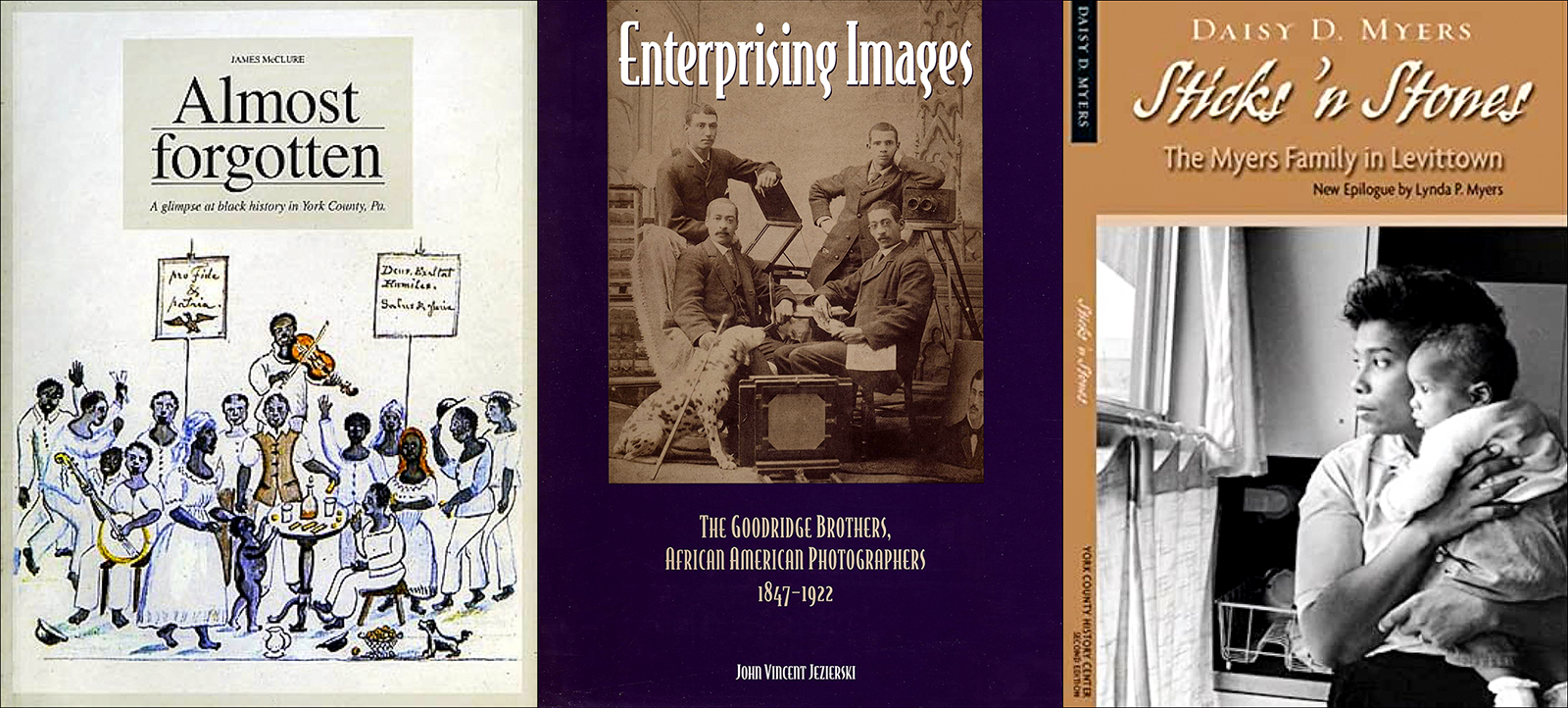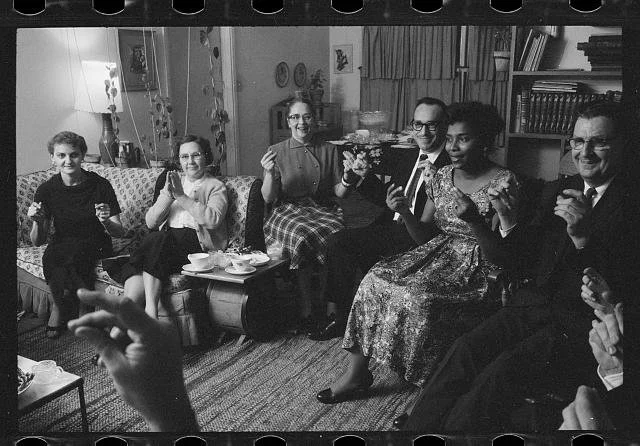Three to Read: Jim McClure on Bringing York’s History to Light
In each Three to Read essay, the writer suggests three books that share a connective thread of interest. Jim McClure continues the series. A slightly modified version of this essay was published in the York Daily Record in May of 2024.
It was early in 2002, and the pressure of a deadline prompted me to make a daily visit to the York County History Center archives.
I remember archives staffers Lila Fourhman-Shaull, Lamar Matthew and Nancy Amspacher working steadily on an Underground Railroad exhibit. They would put their recent findings in a growing Black history file that nearly filled one of those large, gray storage boxes back in the stacks.
They were aware of an upcoming statewide event scheduled later that year that the History Center – then the Heritage Trust – would co-sponsor: the 25th annual Conference on Black History in Pennsylvania.
I was writing a book that would come as part of the conference, “Almost Forgotten,” so I faced a firm deadline.
I had brought forward Black history stories from my previous two books: “Never to be Forgotten,” a 1999 general county history, and “Nine Months in York Town,” the story of the county in the American Revolution. I was busy on microfilm searching for more. Wm. Lee Smallwood had written some Black history pieces that were helpful, as well. And I remember the delight on the faces of researchers in the History Center archives when they pointed out new Black history stories they had uncovered.
The research done and book in draft form, I sat in the York Daily Record conference room with Smallwood, Voni B. Grimes and Ray Crenshaw as they reviewed the final manuscript, made some suggestions and indicated that “Almost Forgotten” would make a contribution. The book thereby passed a big hurdle. These statesmen in the Black community had signed off on it.
That was no small thing, as was the work in the History Center archives, then headed by archivist June Burk Lloyd. The Pennsylvania Historical and Museum Commission was holding the Black history conference to deepen understanding on the topic and to bring the community together at an unsettling moment. This was the era of the divisive and wrenching race riot trials in which a dozen defendants, including York Mayor Charlie Robertson, were on trial in the 1969 shooting deaths of a Black woman and white police officer 30 years before.
Three literary forms emerge
Those days came to mind several weeks ago as I prepared to write a Three to Read piece about three books that bore a connective thread.
I immediately thought about “Almost Forgotten” and then two other books on Black history that bookended that work.
Those other two books — John V. Jezierski’s “Enterprising Images,” about York’s three Goodridge brothers who became pioneering Black photographers, and Daisy Myers’ autobiography “Sticks ’n Stones” — had a national scope. All three books — Jezierski’s, Myers’ and “Almost Forgotten” — tell about the Black experience in York County in three literary forms: biography, autobiography and general history, respectively.
Jezierski, a professor at Michigan’s Saginaw Valley State University, was drawn into the story of William C. and Evalina Goodridge’s three photographer sons - William O. and Wallace L. Goodridge had operated a studio near where Jezierski taught. The Saginaw link came after the Goodridge family moved north during and after the Civil War.
William Goodridge, as depicted in Gary Casteel's sculpture that sits (literally) outside of York's Goodridge Freedom Center. Photo copyright by Andrew Smith.
William C. Goodridge was well-established and successful in York County for his involvement in business, abolitionism, and the Underground Railroad. His name appeared on a barbershop as late as 1865. He left York County, in part, because of trumped-up rape charges against Glenalvin, his oldest son and a pioneering photographer. Glenalvin Goodridge was imprisoned, became ill, and gained a pardon from Pennsylvania’s governor on the condition that he leave Pennsylvania.
Jezierski visited the York County History Center’s archives and thoroughly documented his findings on the Goodridge family, bringing research on its members all in one place. I referenced the 2000 work extensively in writing “Almost Forgotten.”
But most importantly, he demonstrated that it was possible to work on a book-length project in an area — York County Black history — that had been little researched at that point. So I had about two years to digest “Enterprising Images” before “Almost Forgotten” came off the press.
Further, Jezierski’s work showed me that a white researcher could effectively publish — and gain community acceptance of that work — on what was really a history of the local Black community. Remember, this was the era of the race riot trials, and racial fissures opened further in the York County community.
Clearly, Jezierski’s work provides a foundation for the Smithsonian to build on in its current project exploring pioneering Black photographers. The Smithsonian has purchased several pieces of Glenalvin’s work as part of that project.
All history is local
Daisy Myers’ story also shows that all history is local. She and her York-born husband, Bill, were the first Black residents to live in Levittown, enduring demonstrations by white residents. Those protests drew state troopers to gain the peace — ordered by a York County native, Gov. George Leader.
“William and Daisy Myers, the first African American residents of Levittown, Pa., socializing with their neighbors” - Look magazine photograph collection (Library of Congress.) While the couple is shown here with friends, public displays in the Levittown community were antagonistic.
The family came back to York County to live and work. Daisy Myers had a long career as an educator and as an aide to Congressman Bill Goodling. About 2005, she approached the History Center to publish her autobiography. I was part of the publications committee that edited and published the manuscript.
The project was significant. Published memoirs from those in the county’s Black community are rare. Before the release of “Sticks ’n Stones,” I am aware of two: Amanda Berry Smith, whose family served as an Underground Railroad operator and later a well-traveled missionary, published hers in 1893. And Carrie Ford, who followed her retirement as a French teacher in York city schools as a missionary in Liberia, published hers in 1994.
After Myers’ memoirs, Voni Grimes published his “Bridging Troubled Waters” in 2008. I don’t know if Myers’ work influenced Grimes to tackle his memoirs. I do know that he invited me to edit his book, and the two of us had Myers’ “Sticks ’n Stones” in hand in our frequent evening editing sessions in his apartment.
As we’ve seen, the History Center played key roles in “Enterprising Images,” “Almost Forgotten” and “Sticks ’n Stones.” That work formed a foundation for future History Center publications that explored Black and civil rights histories: Mary Allienne Hamilton’s biography of leftist newspaper publisher J.W. Gitt, “Rising from the Wilderness”; Scott Mingus’ seminal Underground Railroad history in 2016, “The Ground Swallowed Them Up”; and a 2021 reprint with a new foreword and afterword of “Sticks ’n Stones.”
The History Center’s annual scholarly publication, the Journal of York County Heritage, also regularly explores stories about men and women of all races and classes.
Coming full circle
I was thinking about these things when seeing the Friends of Lebanon Cemetery receive the prestigious Legion of Honor Award from the Four Chaplains Memorial this month. That recognized their work in restoring the historically Black cemetery in North York as well as researching and writing about those buried there. And then Samantha Dorm, Tina Charles and Jenny De Jesus Marshall published their findings digitally and in books.
That initiative comes at a time that at least three museums or cultural centers are opening or on the drawing board that will tell York County’s Black history story. The History Center’s museum in the former Met-Ed steam plant in York will weave in that story in telling an overall county history when the museum opens this summer.
The Crispus Attucks History and Culture Center will focus on city and county Black history with a focus of Crispus Attucks’ role in it. Jeff Kirkland, who has written and presented on Black history for years, is part of the Crispus Attucks team.
The Susquehanna National Heritage Area’s Mifflin House complex in Hellam Township will explore the region’s Underground Railroad past when it opens later this decade.
And the Goodridge Freedom Center, operator of a museum in William C. and Evalina Goodridge’s house, tells stories about the Underground Railroad and Glenalvin Goodridge’s early photography work.
County Black history studies, thus, have come full circle from Jezierski’s “Enterprising Images” to Black history explorations in the Goodridge House, where a statue of William C. Goodridge greets visitors.
Indeed, Black history studies have accelerated from the days in 2002 when History Center researchers were building a single box full of documents about Black history.
Latino studies up next
Our understanding of Latino history in York County is about the level of Black studies 25 years ago.
Latinos have a shorter history – they came to York County from Puerto Rico and Florida for important work in World War II. They worked in the orchards and fields when many farmers were away at war. They continued to come seasonally in the 1950s when local farm labor faced shortages.
They experienced the same type of discrimination in the 1960s as those in the Black community. In fact, Latino leaders worked with Black leaders to highlight common discriminatory practices.
In the 1970s, they formed organizations that underscored the need for translators in court and opened a social and informational center to welcome Latinos to the community.
Today, Latinos represent York County’s largest minority community, with 39,360 residents in 2020.
There is a growing body of source material for historians to work with. For example, this extensive timeline on WitnessingYork.com highlights local Latino history in the past 80 years. And this Witnessing York resource page will give leads for researchers and other interested readers.
When Culture on the Line asks for Three to Read pieces 25 years from now, no doubt there will be some interesting local Latino history books to choose from.
Meeting in York
The 2002 Pennsylvania Historical and Museum Commission conference drew a large audience and effectively brought together community members. A memorable moment came when Daisy Myers and George Leader met at a session at York College — two principals from those late 1950s days in Levittown.
In advance of her message at the 2002 Black history conference in York, Myers said she would encourage more communication among races. A lack of it in 1957 contributed to suspicions about her family and Black people.
Her “Sticks ’n Stones” - and “Almost Forgotten” and “Enterprising Images” - were all about such communications: white and Black researchers and writers working together to tell stories explaining and exploring the lives and times of Black people in York County and beyond.
Almost Forgotten, by Jim McClure
Enterprising Images, by John V. Jezierski
Sticks 'n Stones: The Myers Family in Levittown, by Daisy Myers
Jim McClure is a retired editor of the York Daily Record and has authored or co-authored nine books on York County history. His knowledge of local history benefits his Retro York Facebook group, which has over 30,000 members, and his other works at Witnessing York and Hometown History. Jim holds a master’s in American studies from Penn State.
All works copyright
Jim McClure, the Authors, Publishers, and/or Andrew T. Smith




